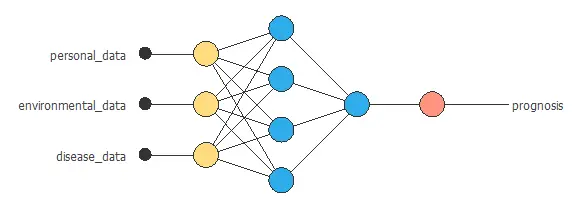Introduction
Predicting patients’ future health is becoming more critical in the clinical decision-making process.
Machine learning and Neural Designer have been used to predict the outcome of diseases and post-operative events, and are increasingly being used in complex medical decision making.
Contents
1. Definition
Medical prognosis consists of predicting the evolution of a patient so that the doctor can select the most appropriate treatment for them.
An example is to predict in-hospital mortality following major lower extremity amputations in type 2 diabetic patients.
Medical prognosis usually comprises one or several of the following metrics:
- Life expectancy.
- Survivability.
- Progression.
- Treatment sensitivity.
On the other hand, many types of variables affect diseases and evolution. Some examples are the following:
- Personal data: Age, sex, weight…
- Environmental data: Smoking, drinking…
- Disease data: Physiological measurements, symptoms…
- Comorbidity data: Aditional conditions…
2. Benefits
2.1. Imrove treatment
Edit “Medical prognosis using machine learning” with Elementor
2.2. Improve wellbeing
Prevent excessive treatment or unnecessary surgical operations.
2.3. Optimize scheduling
Prioritize the care of specific patients based on their prognosis.
3. Approach
Neural networks are the most important technique for machine learning and artificial intelligence. The following flow chart shows how to build and use a neural network for medical prognosis.


The next graph illustrates a neural network for medical prognosis.


To improve the predictive capabilities of the model, we can also apply model selection by trying combinations of variables and choosing those with more impact on the outcome.
Then, the resulting model undergoes an exhaustive testing analysis.

The data science and machine learning platform Neural Designer guides you through this process to focus on the medical aspects and not on the details behind machine learning.
4. Conclusions
- Machine learning enables us to build predictive models that help doctors predict the outcome of a disease and choose the best possible treatment for each patient.
- Medical prognosis is essential for life-threatening diseases such as cancer and other patients who can be more sensitive to aggressive medical treatment, such as older patients.
Relevant documentation:
- To learn more about neural networks, you can read the neural networks tutorial.
- To start applying machine learning using Neural Designer, you can follow the 7 steps to build a neural network.
- You can also practice with the 16 machine learning examples in healthcare & medicine.
References
- Kourou, K., Exarchos, T. P., Exarchos, K. P., Karamouzis, M. V., & Fotiadis, D. I. (2015). Machine learning applications in cancer prognosis and prediction. Computational and structural biotechnology journal, 13, 8-17.
- Burke, H. B., Goodman, P. H., Rosen, D. B., Henson, D. E., Weinstein, J. N., Harrell Jr, F. E., … & Bostwick, D. G. (1997). Artificial neural networks improve the accuracy of cancer survival prediction. Cancer, 79(4), 857-862.
- Ohno-Machado, L. (2001). Modeling medical prognosis: survival analysis techniques. Journal of biomedical informatics, 34(6), 428-439.





